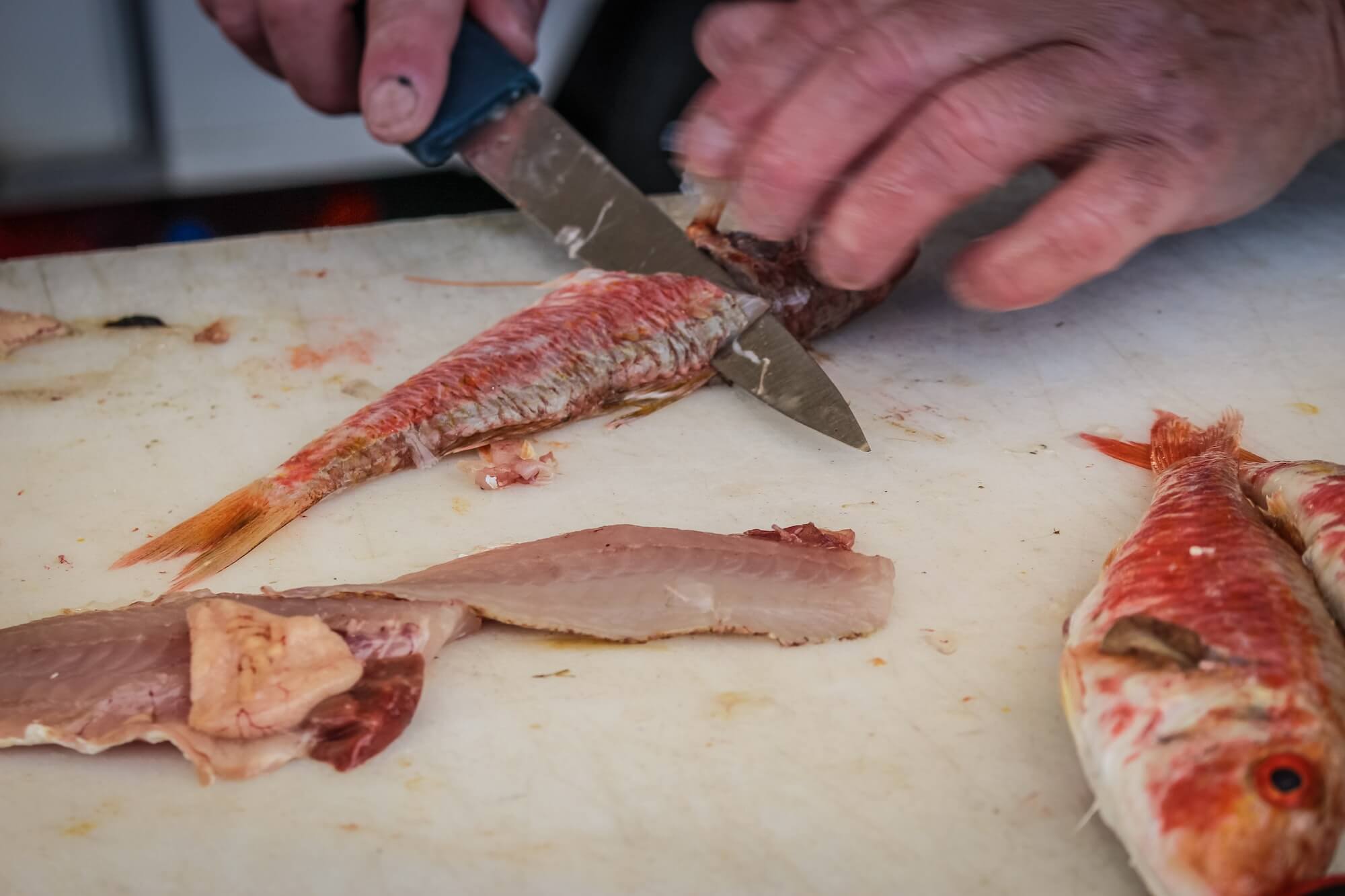Welcome to the world where a simple slice can transform your catch of the day into a gourmet delight. The secret? A trusty fillet knife. This isn't just any kitchen tool; it's your culinary co-pilot, guiding you from rough cuts to refined dining. Whether you're a kitchen novice or a seasoned chef, the right fillet knife can elevate your fish preparation from frustrating to fascinating.
In this guide, we slice through the noise to bring you the best fillet knives on the market. Ready to find your perfect kitchen companion? Let's cut to the chase!
🤝As an Amazon Associate, we earn from qualifying purchases made through our links, at ZERO additional cost to you.
5 Best Fillet Knives
- Best Overall: Dalstrong Gladiator Series Fillet Knife
- Editor's Choice: Victorinox Fibrox Pro Fillet Knife
- Best Splurge: WÜSTHOF Classic Fillet Knife
- Best for Big Catches: Bubba 9 Inch Stiff Fillet Knife
- Best on a Budget: Rapala Fish 'N Fillet Knife
1. Best Overall
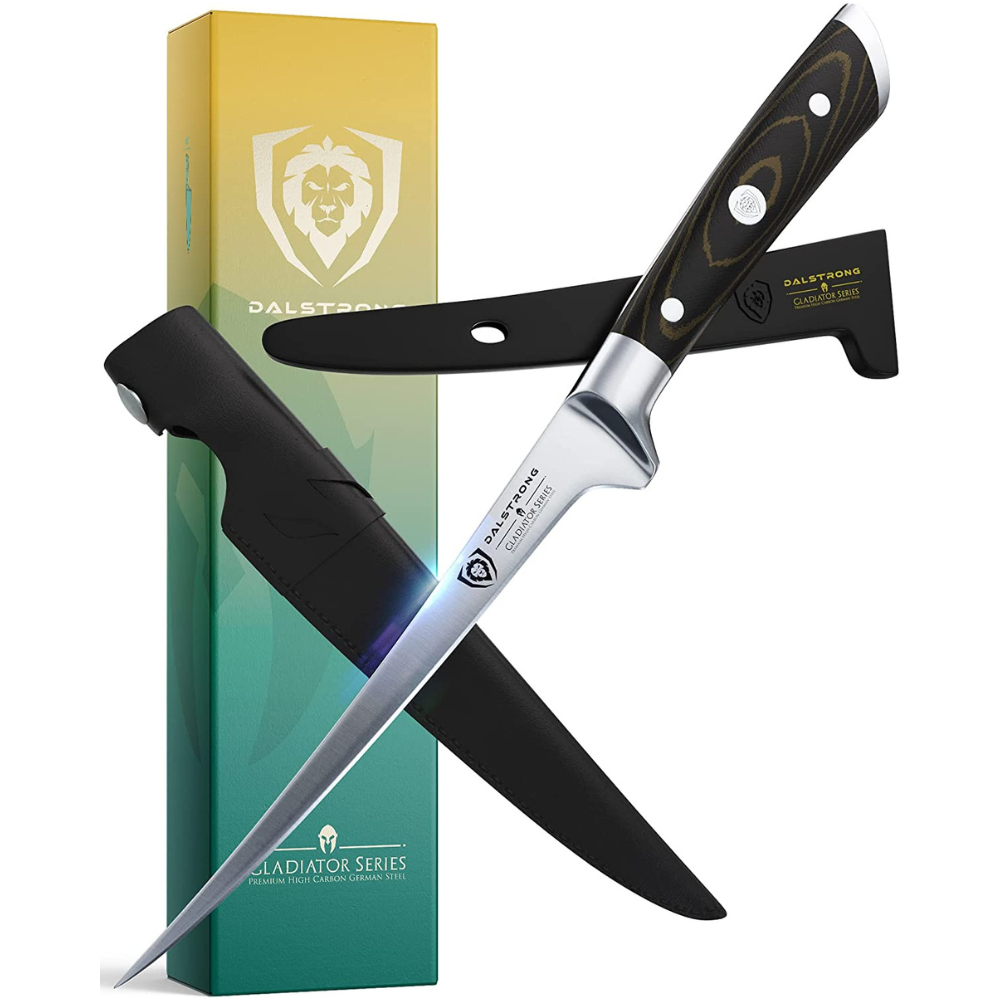
Dalstrong Gladiator Series Fillet Knife
The Dalstrong Gladiator Series Fillet Knife strikes an excellent balance between quality and affordability. Its German high-quality steel blade, ergonomic Pakkawood handle, and versatility make it an outstanding choice for both professional chefs and home cooks. The inclusion of two sheaths for different environments adds to its appeal, making it a top pick for its price range.
What We Love
- Ultra-Thin Blade: German high-quality steel blade, ideal for precision cuts.
- Ergonomic Handle: Comfortable Pakkawood handle, designed for durability and ease of use.
- Versatile Sheaths: Includes both a traditional plastic sheath and a leather sheath for indoor and outdoor use.
- Exceptional Value: Offers high-end features at an affordable price point.
- Professional Grade: Suitable for both professional chefs and home cooks.
What to Keep in Mind
- Price Point: While not the cheapest, it offers great value for its quality.
Why It Might Be Right for You
Picture yourself mastering the art of filleting with the Dalstrong Gladiator Series Fillet Knife, a tool that epitomizes excellence without breaking the bank. This knife isn't just about making precise cuts; it's about empowering your culinary aspirations, whether you're a seasoned chef or a passionate home cook. Its blend of ergonomic design, versatile functionality, and affordability makes it a quintessential choice for anyone who values both quality and value in their kitchen arsenal.
Customer Review (source: Amazon)
I've always been passionate about fresh seafood, and having the right tools like a fillet knife is crucial in my kitchen. Unlike a boning knife, which is great for meats, a fillet knife is a game-changer for fish, with its curved, thin, and flexible blade. I recently tried the Dalstrong fillet knife, and it's a cut above the rest. It's not just for professional chefs; its balance, sharpness, and easy cleaning make it perfect for anyone serious about their seafood. The mirror-finish blade and the dual sheath options, including a handy outdoor sheath, really impressed me. Owning several Dalstrong knives, I can confidently say this one lives up to their high standards. It's an investment that's absolutely worth it for seafood lovers like me.
2. Editor's Choice
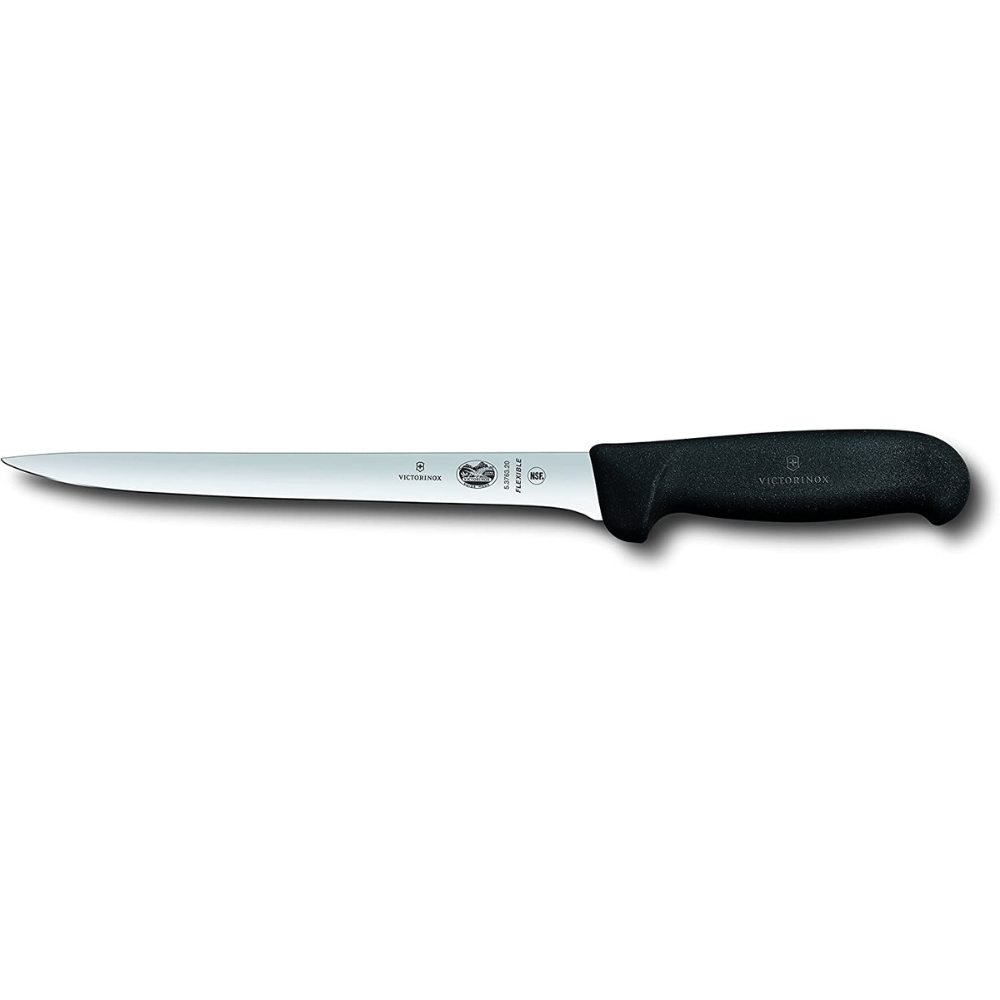
Victorinox Fibrox Pro Fillet Knife
The Victorinox Fibrox Pro stands out for its exceptional durability, ergonomic handle, and high-quality steel blade. It's a perfect blend of comfort, precision, and longevity, making it a top pick for both amateur and professional chefs.
What We Love
- Exceptional Durability: Superior quality material ensures longevity, lasting 6 to 7 years with indoor use.
- Ergonomic Fibrox Handle: Offers a firm grip even when wet, enhancing usability and control.
- Comfortable for Extended Use: Designed for comfort, making it ideal for long filleting sessions.
- High-Quality Steel Blade: Stamped high-carbon stainless steel blade, ice tempered for toughness and durability.
What to Keep in Mind
- Price Point: While offering great value, it may be a higher investment compared to some other options.
Why It Might Be Right for You
The Victorinox Fibrox Pro Fillet Knife is more than just a tool; it's a reflection of culinary dedication. Its ergonomic handle and robust blade are designed for those who demand precision and comfort in every slice. Ideal for both professional chefs and home cooking enthusiasts, this knife represents a harmonious blend of Swiss craftsmanship and practical functionality, making it a top choice for any culinary challenge.
Customer Review (source: Amazon)
I bought this knife mainly for filleting fish and right out of the box, it was razor-sharp. It feels great in hand, has just the right amount of flex, and the handle is comfortable. Sharpening it is a breeze too. For the price, this knife is simply awesome.
3. Best Splurge

WÜSTHOF Classic Fillet Knife
For those willing to invest more in a premium product, the WÜSTHOF Classic Fillet Knife offers top-tier quality. Its high-carbon steel blade, flexibility, and longevity, combined with its suitability for both beginners and professionals, justify its higher price point.
What We Love
- Precision Cutting: Ideal for creating wafer-thin fillets and precise meat cuts.
- Flexibility and Control: Elongated, flexible blade for smooth movement along fish backbones.
- Quality Material: High-carbon steel blade, resistant to corrosion and dulling.
- Longevity: Durable construction with a lifespan of several years.
- Ease of Use: Suitable for beginners, offering easy control and efficient skin removal.
What to Keep in Mind
- Sharpness Caution: Extremely sharp blade; not recommended for tasks like fruit peeling.
Why It Might Be Right for You
Embrace the luxury of the WÜSTHOF Classic Fillet Knife, a symbol of culinary prestige and performance. This knife is for those who see value in investing in top-notch quality. Its superior craftsmanship and unparalleled precision make every filleting task a refined experience. Whether you're an aspiring gourmet or a culinary connoisseur, this knife is a testament to your commitment to excellence in the kitchen.
Customer Review (source: Amazon)
Fishing, especially for salmon in the Pacific Northwest, is more than a hobby for me; it's a passion. That's why I always choose the best gear, like the Wüsthoff 7" fillet knife. Its exceptional construction, comfortable grip, and razor-sharp blade make filleting a smooth process. It easily glides along the backbone for perfect fillets and simplifies bone and fin removal. As someone with 59 years of fishing experience and numerous knives in my collection, I can say without a doubt, this is the best fillet knife I've ever owned.
4. Best for Big Catches
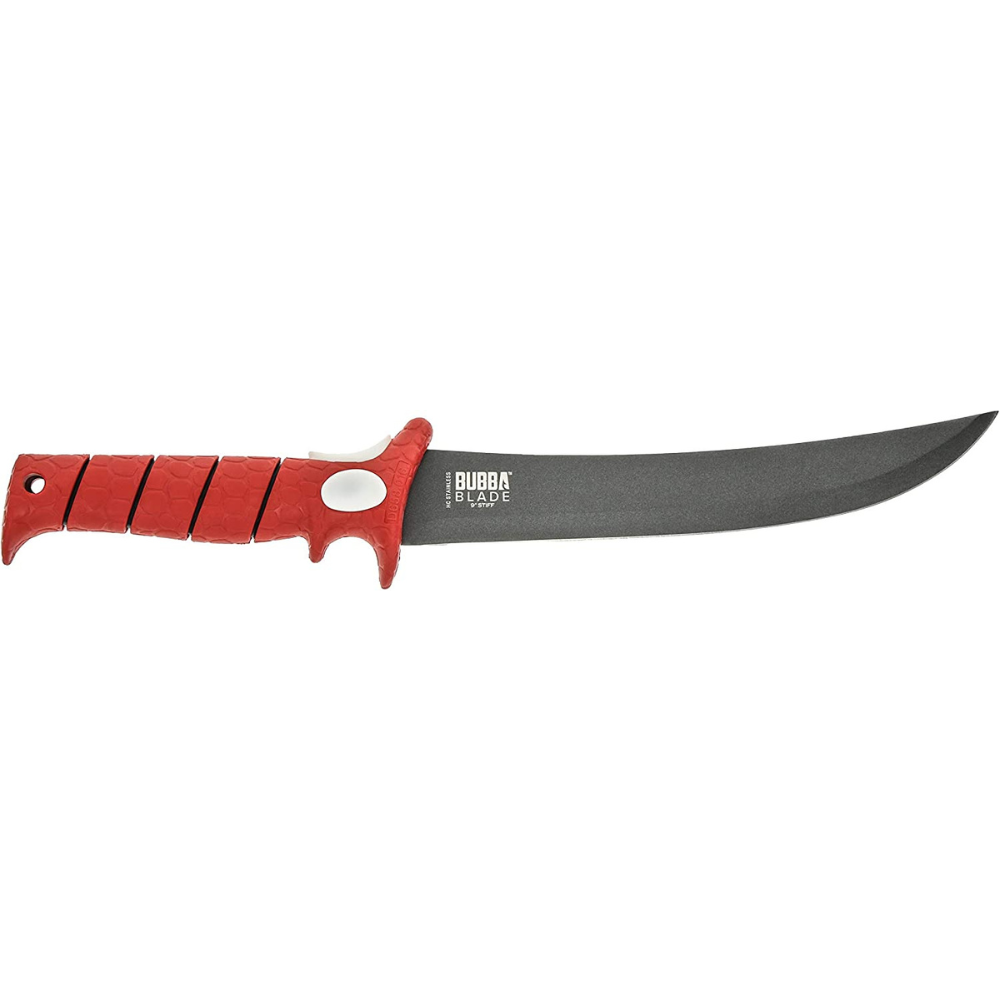
Bubba 9 Inch Stiff Fillet Knife
With its thicker blade and rugged design, this knife is specifically tailored for handling large fish and tough outdoor conditions, making it ideal for anglers and outdoor enthusiasts.
What We Love
- Strength for Big Catches: Ideal for handling large fish like Tuna, with a stiff, thick blade.
- Enhanced Safety: Non-slip grip handle and safety guards protect against slips and cuts.
- Durability: Built to last, with a robust design and materials that withstand heavy use.
- Precision Cutting: Despite its thickness, the blade allows for precise filleting and bone cutting.
What to Keep in Mind
- Less Flexibility: The thicker blade offers less flexibility compared to traditional fillet knives.
Why It Might Be Right for You
The Bubba 9 Inch Stiff Fillet Knife is your rugged companion for the great outdoors. Tailored for the adventurous soul, this knife thrives in the hands of those who tackle big catches and aren't afraid of a challenge. Its robust build and firm grip offer the confidence needed to handle larger fish with ease, making it an essential tool for anglers and outdoor enthusiasts who demand strength and reliability in their gear.
Customer Review (source: Amazon)
I recently got the Bubba Blade 9 Inch Stiff Fillet Knife, and it's incredible! It's huge, almost like a small machete, but what really stands out is the handle – the grip is phenomenal. I first used it to carve a prime rib, and even with juices on the handle, there were no issues. It's extremely sharp and comes with a protective sheath, making it great for both kitchen and outdoor use. Although I don't fish as much these days, it's perfect for carving large meats at home. Also, do check out the video review on the product page – it's seriously impressive!
5. Best on a Budget
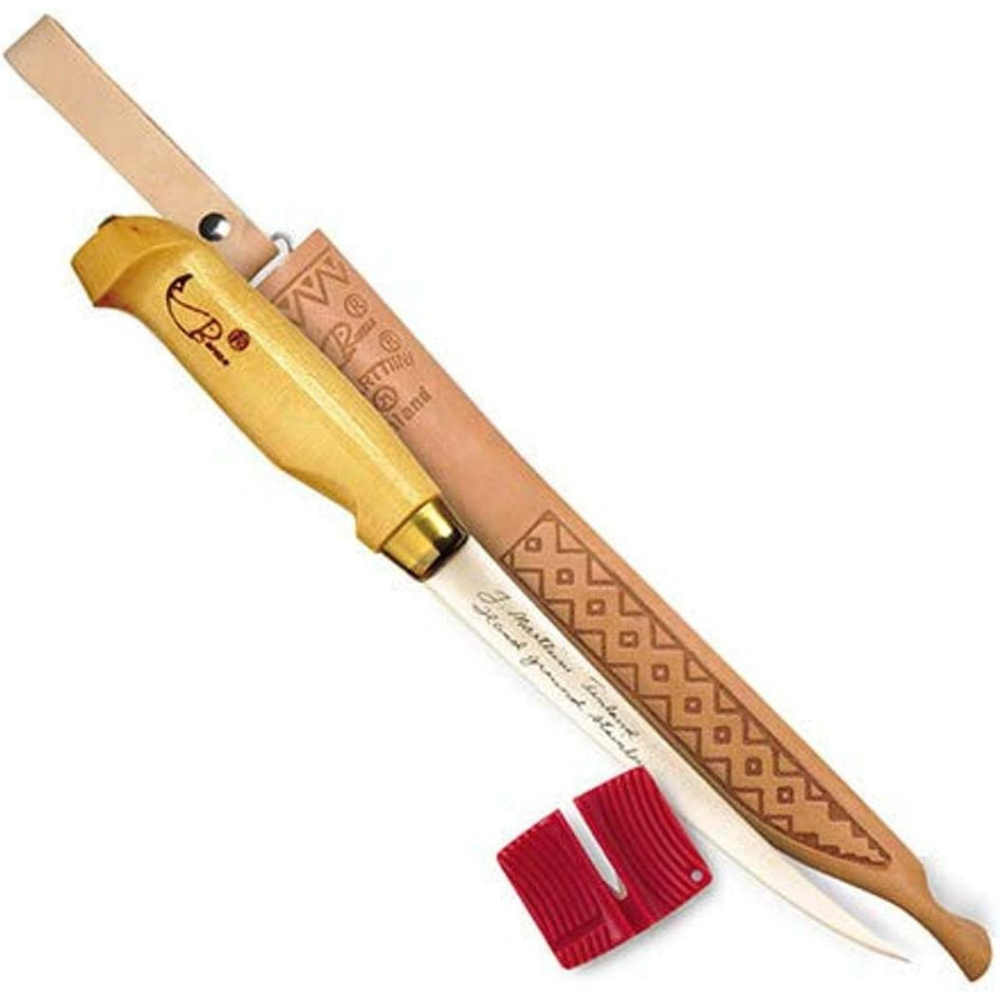
Rapala Fish 'N Fillet Knife
This knife offers a balance of affordability and functionality. Its versatility and vintage design make it a great entry-level option for those new to filleting or working within a tight budget.
What We Love
- Affordable Quality: An excellent choice for those on a budget, without compromising on capability.
- Vintage Aesthetic: Classic birch wood handle offering a traditional look and comfortable grip.
- Versatile Use: Suitable for filleting small to medium-sized fish, as well as cutting fruits and vegetables.
- Beginner-Friendly: An ideal option for those new to filleting, offering ease of use and functionality.
What to Keep in Mind
- Frequent Sharpening: Due to its thin and flexible blade, it may require more regular sharpening.
- Moderate Durability: While not the most durable, it offers reasonable longevity, especially with occasional use.
Why It Might Be Right for You
The Rapala Fish 'N Fillet Knife is a celebration of simplicity and functionality. Ideal for those starting their filleting journey or working within a budget, this knife offers a blend of affordability and versatility. Its vintage charm and practical design make it a great choice for occasional use, providing a reliable and straightforward filleting experience without the hefty price tag.
Customer Review (source: Amazon)
I've had a great experience with this knife, especially considering the price. I used to have one just like it when I first started fishing, which lasted over 30 years until I lost it in a move. Buying another felt like being reunited with an old friend – it looked exactly the same. The blade is nicely flexible, perfect for filleting. The handle can get a bit slippery with fish residue, but it's manageable. What I really appreciate is the sheath; it's handy for tossing in the tackle box without worry. Just a heads-up, it does need regular cleaning to avoid gunk build-up. Overall, for the money, it's a fantastic choice and works really well for me.
How We Chose Our Top Picks
To ensure we provide you with expert insights into these fillet knives, we've undertaken a thorough evaluation process, even if we haven't personally used each product. Our assessment is grounded in extensive research, including a deep dive into user feedback and customer reviews from Amazon. This approach allows us to gauge each knife's performance, durability, and ease of use comprehensively. We also compare these knives against their competitors, offering you a well-rounded perspective to find the perfect tool for your culinary needs.
Our Selection
Our preference leans towards traditional fillet knives, which, in our opinion, offer greater versatility and control compared to some modern variants. Here's a breakdown of our selection criteria:
- Tradition Meets Modernity: While we favor traditional designs for their proven track record, we ensure that the knives incorporate modern enhancements for ease of use and efficiency.
- Blade Quality: A thin, flexible blade is crucial for precise filleting. We scrutinized independent consumer reviews to verify each knife's blade durability and flexibility, ensuring they meet high standards.
- Handle Design and Durability: An ergonomic, easy-to-grip handle is essential for safe and comfortable use. We delved into consumer feedback to assess the longevity of the handles, as a compromised handle can render a knife ineffective.
- Overall User Experience: Beyond the technical specifications, we considered the overall user experience, including ease of maintenance and versatility in various culinary tasks.
By adhering to these criteria, we aim to guide you towards a fillet knife that not only meets your specific needs but also stands the test of time in your kitchen adventures.
What is the Difference Between a Boning Knife and a Fillet Knife?
At first glance, boning and skinning knives may look similar, which is probably why most people confuse the two. However, these two are different from each other. The purpose of a boning knife is to separate bone from the meat, whereas fillet knives are used to cut fish fillets.
Compared to fillet knives, boning knives are heavier and more rigid. A filleting knife is light and flexible. Compared to a bone knife, the blade of a fillet knife is thinner. Both knives have a curve, but the curve on the fillet knife is more pronounced.
Compared to a boning knife, the blade of a fillet knife is more flexible. This flexibility allows fish fillet knives to cut through fish meat easily and make more precise cuts. It also allows it to easily cut the fish meat from the skin and separate it. Boning knives, however, are designed for more demanding use. They cut through connective tissues to separate meat from the bone. If you ever attempt to use a fillet knife for deboning, you will know it is difficult. You may also risk its blade snapping because it's not designed for such use.
How to Choose the Best Fillet Knife
Now that you have decided to buy a fillet knife, you might be wondering how to choose the best fillet knife. We have got you covered. You can use this guide to find the best fillet knife or select one of our top picks.
When it comes to fillet knives, not all are made equal. These knives may cost anywhere from $20 to hundreds. There are many factors at play here that determine the overall quality and functionality of fillet knives.
Type of Fillet Knife
The first decision you have to make is to select the type of fillet knife you will buy. Fillet knives can be differentiated in two ways: modernity and power source. You could buy an electric fillet knife, a folding fillet knife, traditional or nontraditional.
Go for a Traditional Fillet Knife
Traditional fillet knives allow precise cuts. They are the best at extracting the maximum amount of meat from the skin. So, we always recommend going for a traditional fillet knife. All the knives in our top picks are traditional fillet knives.
Electric Fillet Knives
Electric fillet knives make the process of cutting fish fillets easier. However, they require a power source and some practice to use. We do not recommend electric fillet knives for home consumers. A manual traditional fillet knife is the best for noncommercial users who want to fillet fish for domestic use.
Knife Features
The most critical consideration in the knife selection process is the features of its blade. The blade should be thin and durable. Its edge should be sharp and have the right amount of flex: neither be too much nor too little. Also, ensure that the blade length is correct for the fish you are filleting (more on that later).
The fillet knife should also have an ergonomic handle. This handle should comfortably fit your hand and allow you to maintain a grip while handling it. Make sure the handle material is of good quality because when the handle wears off, the blade is of no use to you. Also, check the quality of the blade's sheath because it is essential for safety but overlooked by most people.
Fillet Knife Lengths Explained
Fillet knives are offered in lengths from four to ten inches. You need to match the size of the blade with the length of the blade. Shorter blades are suitable for shorter fish. These fish include yellow perch, crappies, and sunfish.
Fillet knives with blade lengths from six to eight inches are ideal for medium size fishes such as walleyes and trout. Blades of eight to ten inches in length are suited to handle larger fishes such as super-size salmon and broad-shoulder pike.
The best way to go for it is to have a set of two to three different-length knives. The smaller knife could be two to four inches long. The medium Knife could be six to eight inches long. The larger knives could have a blade length of more than eight inches.
Frequently Asked Questions
What makes a good fillet knife?
A good fillet knife is characterized by its flexibility, sharpness, and durability. It should have a thin, flexible blade that allows for precise cuts, and an ergonomic handle for comfortable use.
How is a fish fillet knife different from regular knives?
A fish fillet knife is specifically designed for filleting fish. It typically has a thinner and more flexible blade than regular knives, allowing it to glide smoothly between the skin and flesh of the fish.
What should I look for in a quality fillet knife?
When searching for a quality fillet knife, consider the blade material (usually high-carbon stainless steel), handle comfort, blade flexibility, and overall balance of the knife.
Are most fillet knives versatile for different types of fish?
Yes, most fillet knives are versatile enough to handle various types of fish, from small trout to larger species like salmon. However, the size of the knife should be appropriate for the fish you're filleting.
What defines a high-quality fillet knife?
A high-quality fillet knife is defined by its superior blade sharpness, high-grade materials, ergonomic handle design, and overall craftsmanship that ensures longevity and ease of use.
Which is the best fillet knife for beginners?
The best fillet knife for beginners is one that offers a balance of control, sharpness, and flexibility, making it easier to learn the proper filleting technique without much difficulty.
Can you recommend the best fish fillet knife for professional use?
For professional use, look for a fillet knife that combines precision, durability, and ergonomic design. A knife that can withstand frequent use and maintain its sharpness over time would be ideal.
Which Option of the Fillet Knife Is Best For You?
If you want the perfect Knife to make that perfect cut, all of the options we presented can be great options for you and your home. Now it comes down to personal preference.
We hope this article has clarified what boning knife you want in your home, and we hope you enjoy every cut.
Items reviewed:
- Best Overall: Dalstrong Gladiator Series Fillet Knife
- Editor's Choice: Victorinox Fibrox Pro Fillet Knife
- Best Splurge: WÜSTHOF Classic Fillet Knife
- Best for Big Catches: Bubba 9 Inch Stiff Fillet Knife
- Best on a Budget: Rapala Fish 'N Fillet Knife

Best Overall: Dalstrong Gladiator Series Fillet Knife
The Dalstrong Gladiator Series Fillet Knife strikes an excellent balance between quality and affordability. Its German high-quality steel blade, ergonomic Pakkawood handle, and versatility make it an outstanding choice for both professional chefs and home cooks. The inclusion of two sheaths for different environments adds to its appeal, making it a top pick for its price range.
Please note that the reviews on this page have been edited for readability and clarity while maintaining the essence of the original content.
Further Reading
- Dive into the versatility of fillet knives and their uses beyond fish filleting in our article titled "Exploring the Versatility of Fillet Knives: Beyond Fish Filleting."
- Uncover the basics of perfect knife sharpening angles to elevate your cooking techniques by checking out this detailed guide at Sharpening Supplies.
